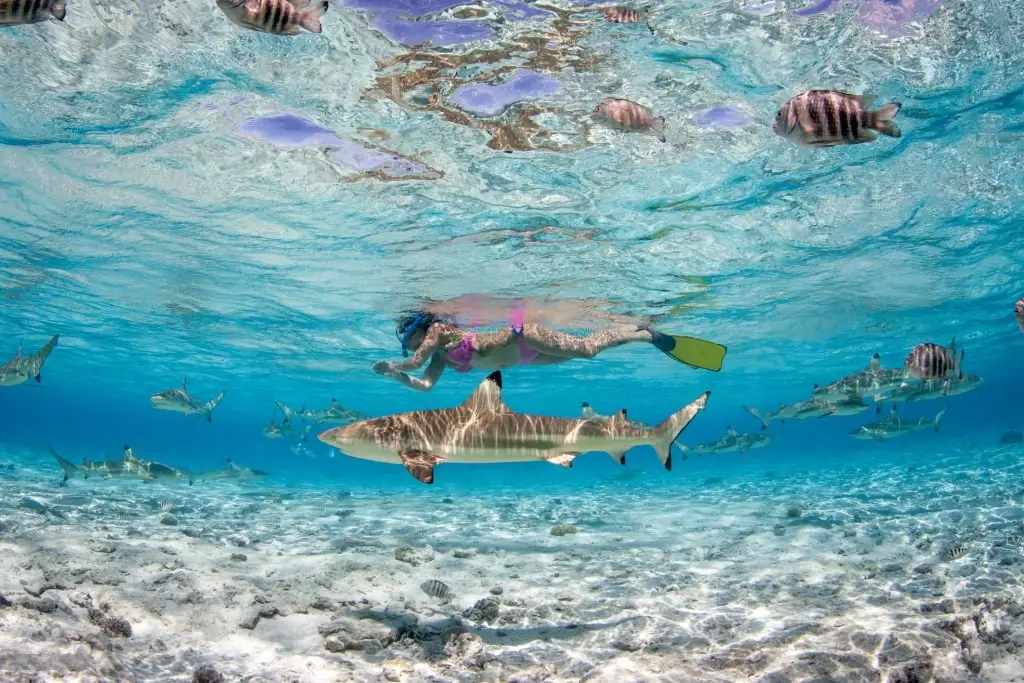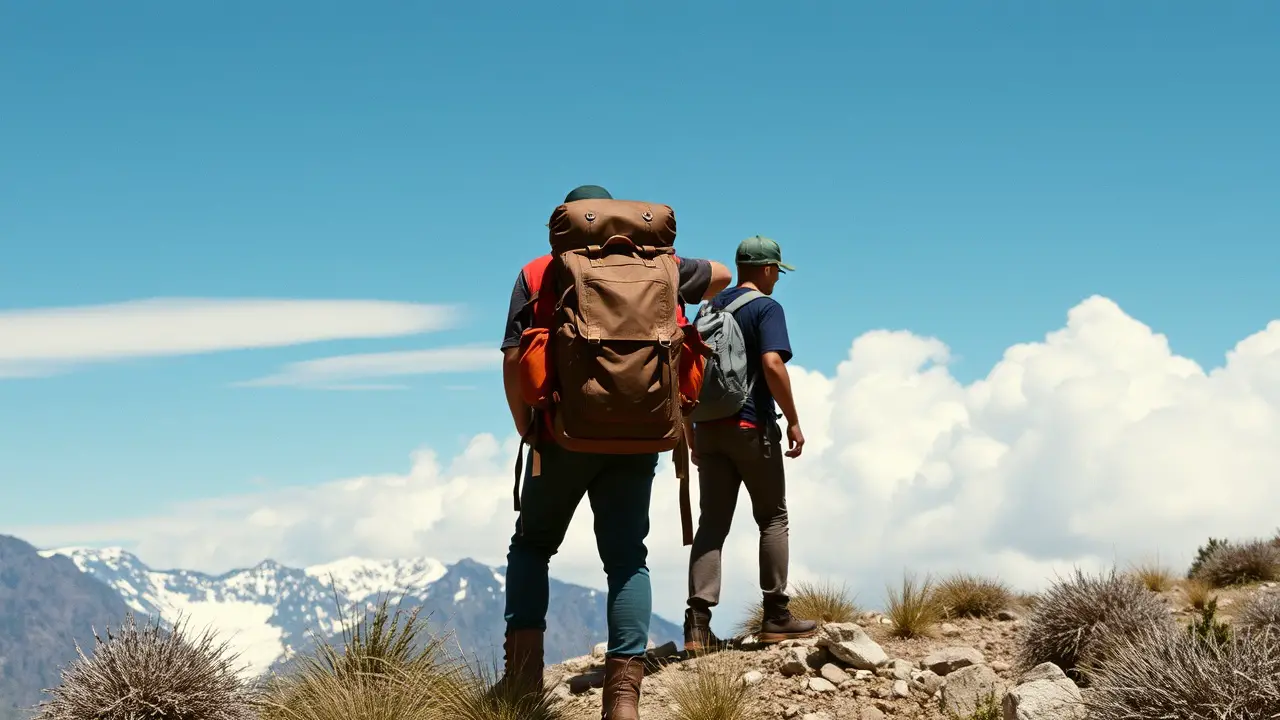Bora Bora Sharks. Sharks are an important part of the ocean ecosystem. They help keep other fish populations in check, which means that shark numbers must be managed carefully to avoid overfishing and ensure their long-term sustainability.
Contents
The awe-inspiring beauty of Bora Bora keeps its visitors coming back year after year. Its turquoise waters and golden beaches remain an important draw for travelers and a source of livelihood for the native population.
With popularity comes attention, and when you live in close proximity to sharks, that means attention is warranted. But how much do you really know about sharks in Bora Bora?
Sharks are one of the ocean’s top predators. The average adult shark is about 12 feet long, but their size can range from 1 to 30 feet. There are 400 species of sharks, and more than half are dangerous.
Some live close to the water’s surface, while others inhabit the depths of the ocean. One thing that they all have in common is that they have very good sonar and amazing senses.
Sharks are a big part of history and have been around for millions of years. They’ve survived extinction because they’re strong and adaptable.
Bora Bora Sharks
Sharks in Bora Bora are not dangerous to humans, but it is recommended to avoid them if you see one. The sharks that can be found in Bora Bora are the white-tip shark and the black-tip shark.
The white-tipped shark is a small species that feeds on crustaceans and small fish, while the black-tipped shark feeds on smaller fish as well as octopus, squid, and crustaceans.
It is important to know that sharks do not like to be approached by humans as this will make them feel threatened, so if you do happen upon a shark, just go about your business as usual and you should be fine!
Some people do not like sharks, but that is because they only see them on television. When you meet one in person, you will find out that they are really friendly and cute.
There are many species of sharks that live around Bora Bora, and it is likely that you will see some of these during your stay. The most common ones are:
White-tipped Reef Shark (Triaenodon obesus): This shark can grow up to 1.5 meters long and has white tips on its fins. They are known for being very aggressive towards humans, so keep well away from them!
Read more articles: How to Pack Eggs for Backpacking?
Map of Bora Bora
5 helpful points to learn
- Bora Bora shark species
- Sharks feeding in Bora Bora
- Shark diving in Bora Bora
- Sharks in Bora Bora lagoon
- Bora Bora shark and ray tours
Bora Bora shark species
Hammerheads: There are three types of hammerhead sharks: scalloped, smooth, and great. These sharks live in tropical waters around the world, but they can be found in Bora Bora Lagoon as well.
Nurse Sharks (Ginglymostoma cirratum): These slow-moving bottom dwellers are one of the rarest shark species on Earth.
Their bodies are flattened, and their noses are turned up like an elephant’s trunk. This gives them the nickname “carpet sharks” because when they lie on their bellies on the sea floor, they look like rugs.
Nurse sharks are also called “tiger nurse sharks” due to their tiger-like coloring with dark spots along their sides, though they are not closely related to tigers at all! The nurse shark is one of the few sharks that can be found in Bora Bora Lagoon.
They are easy to spot because they have a flattened body with an upturned nose that resembles an elephant’s trunk, which earned them the nickname “carpet sharks” because they resemble rugs when lying on their bellies on the sea floor.
Read more articles: How to Backpack with Eggs?
Sharks feeding in Bora Bora
Shark feeding is a popular activity in Bora Bora, and it’s one of the best ways to see sharks, rays, and other marine life. If you haven’t had the opportunity to swim with sharks before, this is an excellent way to learn about them.
There are a few companies that offer shark-feeding tours, including Bora Diving and Shark Divers. Both companies have been around for years and have very good reputations.
Bora Diving is one of the most popular dive shops in Bora Bora. They offer a wide range of services, including shark feeding tours, scuba diving, and snorkeling excursions. The company has been around for years and has a very good reputation.
Shark Divers is another popular shark-feeding tour operator. They offer trips to several islands in French Polynesia, including Bora Bora and Tahiti. Their boats are equipped with snorkeling gear, so you don’t need to bring your own equipment.
The shark feeding tour lasts about three hours and includes a 45-minute boat ride to the feeding area. You’ll also get 30 minutes of free time at each location before heading back to shore.
The shark feeding tour operators have several different types of sharks that you can see. They include white-tipped, gray-reef, and zebra sharks.
The sharks come in from the deep blue sea and swim right up to you. They are very curious creatures and will approach you as long as you don’t make any sudden movements or splash around in the water.
Read more articles: Best Texas State Parks for RV
Shark diving in Bora Bora
Shark diving is a popular activity that is growing in popularity. It involves swimming with sharks, but unlike shark feeding, the purpose of shark diving is not to give food to the sharks. Shark diving involves interacting with and observing these majestic creatures up close.
While shark feeding may sound like an exciting way to get up close and personal with these apex predators (and it can be), it’s important to note that doing so can put both you and the animal at risk by making them lose their natural fear of humans.
This can potentially lead them to be more aggressive towards humans in general, which could result in someone getting hurt or killed!
Sharks have been living on this planet longer than humans have been around; we need to respect their space by giving them room when we see them near our boats or watercrafts, especially if there are multiple people around!
If a person sees an angry-looking mako or great white shark heading towards him or her while on board his or her boat, he or she should try moving away from where they were standing before (but do not jump overboard!).
The best way to avoid being bitten by a shark is to not put yourself in that situation in the first place. If you see a shark near your boat or watercraft, try moving away from where you were standing before (but do not jump overboard!).
Read more articles: Seattle to Yellowstone Road Trip
Sharks in Bora Bora lagoon
The Bora Bora lagoon is a safe place to swim. The sharks are there because the fish that live in the lagoon are also there, so don’t worry about them. Sharks are not dangerous to humans, and they usually aren’t aggressive unless provoked or threatened (not just by people but also by boats).
If you see a shark while swimming in the open ocean, then yes, you should be concerned. But if you see one while swimming at least 20 feet from shore, you’re probably fine!
The sharks in Bora Bora are also not dangerous to humans. They have no reason to be aggressive towards humans, so don’t worry about them! If you see a shark while swimming in the open ocean, then yes, you should be concerned.
But if you see one while swimming at least 20 feet from shore, you’re probably fine! The sharks in Bora Bora are also not dangerous to humans. They have no reason to be aggressive towards humans, so don’t worry about them!
If you see a shark while swimming in the open ocean, then yes, you should be concerned. But if you see one while swimming at least 20 feet from shore, you’re probably fine! The sharks in Bora Bora are also not dangerous to humans.
They have no reason to be aggressive towards humans, so don’t worry about them! If you see a shark while swimming in the open ocean, then yes, you should be concerned. But if you see one while swimming at least 20 feet from shore, you’re probably fine!
Read more articles: Snakes in Spain
Bora Bora shark and ray tours
Bora Bora shark and ray tours are a great way to see these animals up close. You can choose between a day trip or an overnight experience, depending on your preference.
Both options include snorkeling and diving with sharks and rays, as well as meals and lodging at the resort. If you’re interested in learning more about these creatures, this is an excellent opportunity!
The tour is offered by a local company called Shark Divers, which has been operating for over 20 years. They are one of the most well-known dive companies in Bali and have a reputation for offering great experiences at affordable prices.
The tour takes place over two full days, with the first day focusing on snorkeling and swimming with Bora sharks. The second day is spent diving at a reef site, where you can see rays and other marine life as well.
You’ll get to experience both sides of this incredible ecosystem and learn more about these fascinating creatures from the experts.
The tour includes two full days of diving and snorkeling with sharks and rays, as well as meals and accommodation at a nearby resort. You’ll also get to enjoy a free day at your leisure after the tour is over.
Conclusion
You can learn more about the sharks in Bora Bora by visiting our website. There, you will find information on the different types of sharks that live in this area as well as pictures of them.
We also have some great tours available if you want to see them up close or even swim with a shark!
Any living creature can potentially cause harm or injury if it is handled improperly or in certain situations. The fact that sharks have a reputation for being dangerous doesn’t mean they are inherently dangerous.
For example, new divers might not be able to handle certain conditions underwater, which might make a shark approach them differently than it would a pro diver.
Even though the risk of getting hurt by a shark isn’t as high as when driving or crossing the street, precautions should always be taken to lower this risk even more.
Read more articles: Snakes of Spain











Leave a Reply